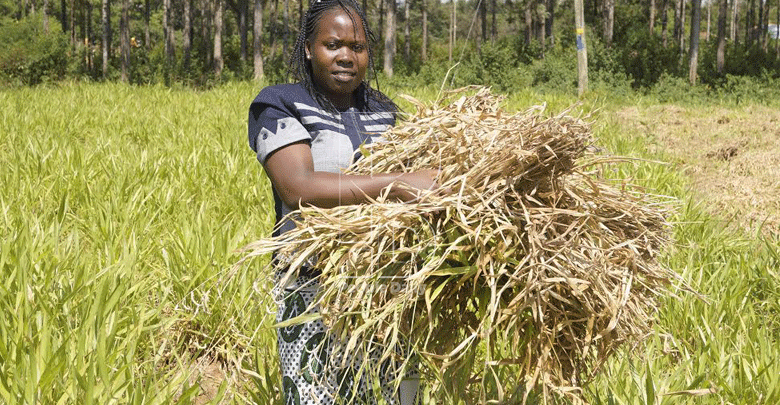Young farmer thrives through fodder crop production
By Clifford Akumu, January 12, 2021Bernadette Nangila surveys her lush quarter of an acre brachiaria fodder farm in Kimwanga village, Bungoma county, making bold steps as she occasionally plucks stubborn weeds off the nutritious grass.
She then arranges the freshly harvested grass into heaps to dry in readiness for baling.
“This farm has changed my life. Without it, I would not have graduated from college,” says the 27-year-old, who used proceeds from her fodder production to pursue a diploma in Business Administration at Jaramogi Oginga Odinga University of Science and Technology.
The youthful farmer has since carved a niche for herself in the venture serving dairy farmers across five counties including Uasin Gishu, Siaya, Kakamega, Busia and Bungoma.
She grows cayman brachiaria variety in two acres of land, cobra variety in three quarter of an acre, piata variety in quarter and xaeres variety in three acres, all in different parts of the county.
Covid-19 effects
She sells fresh grass for Sh200 depending on the quantity needed by farmers while a bale goes for Sh450. She harvests every three months.
“From the first harvest, I got a total of 120 bales from the six acres and up to 300 bales from subsequent harvests.
The yields increase depending on the care given to the grass,” says the youthful farmer who tried twice to work as a house girl in 2015 before settling into farming.
However, the night to dawn curfew imposed by the government to curtail the spread of Covid-19 came about when she had just harvested 200 bales, which she found difficult to sell.
“It was, especially difficult to sell to other counties because the time was limited. I often found myself on the wrong side of the law and get arrested by the police,” she explains.
Left with no choice, she has been selling the fodder at a throw-away price within Bungoma county and some neighbouring counties at Sh200 per bale.
Nangila has trained 200 youths, who grow the grass on small plots of land and later sell to her at an agreed price.
She offers each youth 50 bags of brachiaria vegetative material (splits) to plant, and in return deduct about 100 splits when they sell back to her from the harvest.
She started the venture in October 2018 on a 23-feet by 63-feet plot of land at her Kimwanga village, Bungoma county after investing Sh8,600. She would harvest 70 bales, which she sold at Sh300 each, pocketing a total of Sh21,000.
“I started with one packet of brachiaria seeds. I was also trained on how to prepare the nursery bed, proper management of nursery bed, transplanting and harvesting from Farm Input Promotions Africa Limited (FIPS-Africa),” says Nangila.
The output from the grass was too impressive, she notes, adding that she has farms as far as Kapchai region, still in the county.
Three years later, she has never looked back. Brachiaria fodder is not only hardy, nutritious and easy to digest, but has crude protein content of more than 15 per cent plus other minerals, which are necessary for milk production.
In 2019, Nangila was part of a group of youth that received training and mentorship from the Global Agribusiness Management and Entrepreneurship (GAME) Centre at the United States International University (USIU) Africa that is running the Metro AgriFood Living Lab to address the twin problem of youth unemployment and gender inclusivity.
The programme received support from the Cultivate Africa’s Future Fund (CultiAF), a joint program of International Development Research Centre (IDRC) and the Australian Centre for International Agricultural Research (ACIAR).
“The training provided entrepreneurship, financial literacy, marketing and record-keeping, value addition skills among others,” she explains.
Demand for fodder continues to grow as more farmers adopt improved techniques in the dairy sector, including zero grazing for optimum production.
“I have received support in marketing my fodder from different partners, includingfrom German development agency, GIZ and FIPs Africa through advertising on local media stations,” she says.
How it is grown
The grass grows in well-drained soils of medium to high fertility with a pH of five to eight.
The fodder is cultivated through seeds and splits. However, the vegetative material is cheaper and faster in growth compared to the seeds.
“I use farmyard manure during top-dressing. And after a month or two, the grass reaches three feet high, ready to feed to the animals.
Then after every month, a farmer continuous to harvest the grass. It is also advisable to harvest shortly before the grass is fully mature as this is the time they have high nutrients,” explains Nangila.
Production challenges
Pests such as spider mites are a major challenge in brachiaria production. There are also cases where the crop wilts in different ecological zones.
“For example, I released two sacks of 50kgs splits to youths and when they planted, their grass started wilting on a portion of three-quarter of an acre.
I reported the challenges to the county agricultural office and they have since taken the matter trying to research the cause,” she explains.
Another challenge is that in brachiaria fodder production is during the harvesting period because it causes irritation when it gets into contact with the skin. They also encounter snakes or porcupines during the harvesting period.
The Covid-19 restrictions have pushed her to diversify into another agribusiness venture, rabbit keeping, to supplement her income.
She has 64 rabbits preferring the New Zealand White, Chinchilla and Kenya One breeds. Most of his customers are hoteliers, non-governmental organisations and researchers.
Two weeks and three-day-old Newland breed goes for Sh350 while Kenya white goes for Sh250. The bigger ones go for between Sh750 and Sh1,500 depending on the breed,” she says.
She uses weeds and fodder from her farm to feed the rabbits. She says rabbits have a ready market and have a good turnaround on investment.
Besides rabbit farming, she also runs a pharmaceutical kiosk in Kimaiti Shopping Centre on the busy Bungoma-Malaba Highway.
